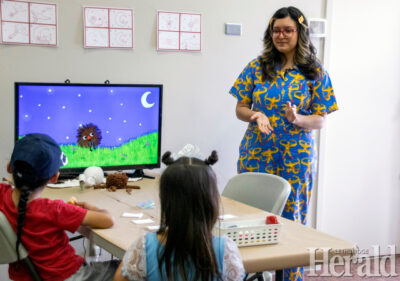Exhibit showcases Indigenous artists
By Alexandra Noad - Lethbridge Herald Local Journalism Initiative Reporter on June 25, 2024.
 Herald photo by Alexandra Noad
Madeson Singh presents her animation of a traditional Cree story about a whooping crane for the BuffaloMech exhibit on Friday at Fort Whoop-up.
Herald photo by Alexandra Noad
Madeson Singh presents her animation of a traditional Cree story about a whooping crane for the BuffaloMech exhibit on Friday at Fort Whoop-up.Fort Whoop-Up held an exhibit on Friday showcasing the work of five Indigenous artists’ research projects exploring Indigenous technologies to celebrate National Indigenous Peoples Day.
Historically, Indigenous people were not welcome in the fort unless it was to trade goods or were put in jail.
Walker English (Piitakyatsis) did his project on the stereotyping of Indigenous people. He says he would love to see more representation of his culture in museums, schools and galleries as it would help people understand his culture better.
“I think more representation is always a good thing because it brings people together. It allows Indigenous peoples to be themselves, tell their stories, and other people can learn from that and connect through that,” said English.
Zoe Buckskin did her project on Blackfoot story robes, which are being displaced and appropriated in British museums. She agrees Indigenous voices should be amplified, especially in the art world.
“I think it’s just getting Indigenous voices and people into these spaces and just kind of allowing people and especially natives to express themselves, especially within the art world,” said Buckskin.
Buckskin added a great way to support Indigenous artists is to purchase artwork, specifically bead-work, from them because a lot of time and money goes into it.
Story-telling is a huge part of Indigenous culture. For Madeson Singh, a Panjabi Cree, growing up she didn’t see representation of either of her cultures. Her project was an animation of a Cree story about a Whooping-Crane and she hopes this Technology will help young Indigenous people feel connected to their culture.
“Growing up I didn’t really see a lot of representation for my Cree heritage or even my Punjabi heritage, and especially not like Cree Panjabi. So I think like being able to create your own representation is really awesome,” said Singh
Another focal point in Indigenous cultures is respecting the land. Lily Wells did her project on tree burials and how it represents the circle of life, while giving back to the land.
“This is something that really special because it’s the cycle of life. Death In society today it is a negative experience but, for our people it is rejoice and this is part of it. The body goes back to every being to fertilize everything and come back,” said Wells.
Many residential school survivors were convinced the traditional ways of their people were bad and shouldn’t be shared with their loved ones. Darby Herman did her project on family ties in Indigenous culture. She believes loved ones who pass on watch over and protect those who are living.
“Being part of an Indigenous community, means family. It’s those family connections that don’t just last with people that are here, but the ones that pass on still watch over us,” said Darby Herman.
English says the best way to promote reconciliation is to learn from each other.
“We can’t do anything to fix the wrongs of what has happened but, I think what we can do is we can learn from each other, get to know each other better. I think just becoming more of a family is the best thing to do.”
16-15


